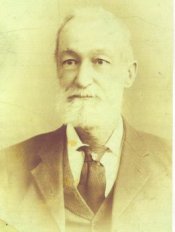|
The "West of England Cloth"
Factory and the Tale of the Victorian Factory Owner and his Runaway Daughter. Soon after we moved to our old farmhouse on the southern border of Somerset, we were told of a mill which once stood in the field opposite. We could find little trace of it when we searched, just a few old stones amongst the brambles and nettles. Living
in, and renovating, an old house (Court Farmhouse) arouses the curiosity
about the past; of the people who lived there and the manner of their
lives. For the first three years we were so busy with the house in all
our "leisure" hours that we had no time to look beyond it, but
gradually, as we began to know the villagers we heard snippets of
information about "The Factory" as it was called. We
discovered that this ancient village (recorded as part of the property
of the Bishop of Wells in 1206 - a gift of King John) had progressed
from rural poverty to relative prosperity in Victorian times. This was
largely due to the work provided by the Woollen Factory.
Built
in the early 19th century, four storeys high of local stone, the factory
was large and conspicuous; standing on the edge of the village beside a
spring, one of many which fed the River Axe, a short walk further down
in the valley, it used the water to power the machinery.
In
addition to the 12 farms of the village and surrounding area, the
Factory employed a large proportion of the population, which grew from
764 inhabitants in 1802 to 1,062 in 1851; this period being the heyday
of the cloth production. They walked to work in clogs, made by the
cobbler in the village, and the children went too. It is said that at
one time 600 people were employed there, including
the man who took a cart round the village
every day to collect the urine from householders
willing to save it! Their annual payment for this was a length of cloth.
The urine was used in the scouring (cleaning) and possibly the fulling
or milling (thickening by controlled shrinkage) of the cloth. It may
also have been used during the dyeing but, since all the records have
been lost, we do not know whether the dyeing was done here. In any event
the dyes would have been 'natural' since synthetic dyes had not yet been
discovered. Teasels were grown locally and used to 'nap' or raise the
fibres on the face of the fabric. These still grow wild in a nearby
field and down by the river.
The Victorian owner of the mill was a pillar of local society, Mr
Samuel Ousley Bennett (see picture on left). He and his wife Mary Jubilee, whom he
married in 1829, prospered and raised a large family of eleven
children, all born between 1830 and 1850. Samuel and Mary enjoyed
the love and respect of their children - proof of this is shown in
a letter from Susan, their fourth daughter, written in 1888 from
Sioux City, Iowa, United States of America: "Dear
- dear Father how I long to see you, and what would I give to have
a talk with Mother angel Mother - and I crave her forgiveness for
all my wayward and self-willed actions and words that children
should never utter to Parents, indeed I could live more
contentedly could I but have had her blessing - and now dear
Father send me yours.
I know we all have your devoted love
and best of wishes, and I hope your life may be spared many years, so
that we may enjoy the honour and privilege of possessing a good and
righteous earthly parent, one that indeed commands our love and
respect". Susan writes
longingly of her father's nice fresh vegetables and "the monster
gooseberries that used to grow on the home bushes". Apparently
fresh fruit was scarce in Sioux City in 1888 and they depended largely
on canned and bottled fruit. Judging by Susan's remarks about her "wayward
and self-willed actions" and also by the behaviour of her
youngest sister, bringing up children was as difficult in those days as
it is today.
To see the actual
letter, click here.
Victorian Melodrama
Meanwhile,
back at the village, Father had discovered that his youngest daughter
was missing, so saddled up and grabbed his shotgun (accompanied by a
roll of notes on the piano...) and rode into town. TOO LATE!! They were
already married. "Never darken my doorstep again!" The
young couple went to London where Mr Bacon became a hansom cab driver
and they presumably lived happily ever after, since it was Lavinia's
grand-daughter who told this tale to me.
By
1850 the woollen trade had gone to the North and the Factory closed. By
the 1860's the community was described as being more like a decayed town
than a rural village. Susan, in her letter, writes of the pleasure at
hearing from her father that the Factory may be utilised again, but for
what purpose she does not say. Four years later her father died (1892).
My research could uncover no more information about the Factory until
1914 or thereabouts. The oldest inhabitant of the village recalls going
there during the First World War for dances where the owner played the
melodium. The old building was also used for band practice in 1935. It
was demolished during the Second World War and the stone used at the
aerodrome in Somerset. |
 The product was
West of England Cloth - a strong, dense, napped woollen cloth capable of
keeping out the wind and wet of the West Country; important in the days
before weather proofing.
The product was
West of England Cloth - a strong, dense, napped woollen cloth capable of
keeping out the wind and wet of the West Country; important in the days
before weather proofing.